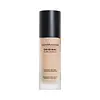Original Pure Serum Radiant Natural Liquid Foundation Mineral SPF 20
Color: Fair Cool 1What's inside
What's inside
 Key Ingredients
Key Ingredients

 Benefits
Benefits

 Concerns
Concerns

 Ingredients Side-by-side
Ingredients Side-by-side

Zinc Oxide 12%
Cosmetic ColorantWater
Skin ConditioningSqualane
EmollientShea Butter Ethyl Esters
EmollientIsoamyl Laurate
EmollientPolyglyceryl-3 Ricinoleate
EmulsifyingButyloctyl Salicylate
Skin ConditioningPropanediol
SolventIsopropyl Isostearate
EmollientPolyglyceryl-3 Diisostearate
EmulsifyingMethylpropanediol
SolventNiacinamide
SmoothingSodium Chloride
MaskingLecithin
EmollientCaprylyl Glycol
EmollientSilica
AbrasiveAloe Barbadensis Leaf Juice Powder
Skin ConditioningBisabolol
MaskingHydrolyzed Sodium Hyaluronate
Skin ConditioningAllantoin
Skin ConditioningPhenylpropanol
MaskingSodium Myristoyl Glutamate
CleansingSodium Hyaluronate
HumectantTetrasodium Glutamate Diacetate
Aluminum Hydroxide
EmollientPolyhydroxystearic Acid
EmulsifyingCI 77491
Cosmetic ColorantCI 77492
Cosmetic ColorantCI 77499
Cosmetic ColorantCI 77891
Cosmetic ColorantZinc Oxide 12%, Water, Squalane, Shea Butter Ethyl Esters, Isoamyl Laurate, Polyglyceryl-3 Ricinoleate, Butyloctyl Salicylate, Propanediol, Isopropyl Isostearate, Polyglyceryl-3 Diisostearate, Methylpropanediol, Niacinamide, Sodium Chloride, Lecithin, Caprylyl Glycol, Silica, Aloe Barbadensis Leaf Juice Powder, Bisabolol, Hydrolyzed Sodium Hyaluronate, Allantoin, Phenylpropanol, Sodium Myristoyl Glutamate, Sodium Hyaluronate, Tetrasodium Glutamate Diacetate, Aluminum Hydroxide, Polyhydroxystearic Acid, CI 77491, CI 77492, CI 77499, CI 77891
Caprylic/Capric Triglyceride
MaskingCoconut Alkanes
EmollientMica
Cosmetic ColorantSilica
AbrasiveStearalkonium Hectorite
Gel FormingCoco-Caprylate/Caprate
EmollientGlycerin
HumectantLecithin
EmollientJojoba Esters
EmollientPropylene Carbonate
SolventPhenoxyethanol
PreservativeTocopheryl Acetate
AntioxidantButylene Glycol
HumectantWater
Skin ConditioningMagnesium Ascorbyl Phosphate
AntioxidantNymphaea Alba Flower Extract
Skin ConditioningSodium Hyaluronate
HumectantCI 77891
Cosmetic ColorantIron Oxides
Caprylic/Capric Triglyceride, Coconut Alkanes, Mica, Silica, Stearalkonium Hectorite, Coco-Caprylate/Caprate, Glycerin, Lecithin, Jojoba Esters, Propylene Carbonate, Phenoxyethanol, Tocopheryl Acetate, Butylene Glycol, Water, Magnesium Ascorbyl Phosphate, Nymphaea Alba Flower Extract, Sodium Hyaluronate, CI 77891, Iron Oxides
 Reviews
Reviews

Ingredients Explained
These ingredients are found in both products.
Ingredients higher up in an ingredient list are typically present in a larger amount.
Ci 77891 is a white pigment from Titanium dioxide. It is naturally found in minerals such as rutile and ilmenite.
It's main function is to add a white color to cosmetics. It can also be mixed with other colors to create different shades.
Ci 77891 is commonly found in sunscreens due to its ability to block UV rays.
Learn more about CI 77891Lecithin is a term for a group of substances found in the cell membranes of plants, animals, and humans. They are made up of mixture of phospholipids.
This ingredient has emollient and emulsifying properties.
As an emollient, lecithen helps soften the skin and creates a barrier to keep moisture in.
As an emulsifier, it also helps prevent water and oil ingredients from separating. Lecithin can also help ingredients be better absorbed by the skin.
This is because the phospholipids in lecithin produce liposomes. Liposomes help other ingredients get through the skin barrier.
Depending on the source of this ingredient, lecithin may not be fungal acne safe. This is because some sources of lecithin come from soybean oil, which may feed the malassezia yeast that feeds fungal acne.
We recommend reaching out to the brand you are purchasing from to inquire about the source of their lecithin.
Some other names for this ingredient include soy lecithin and deoiled soy lecithin.
Learn more about LecithinSilica, also known as silicon dioxide, is a naturally occurring mineral. It is used as a fine, spherical, and porous powder in cosmetics.
Though it has exfoliant properties, the function of silica varies depending on the product.
The unique structure of silica enhances the spreadability and adds smoothness, making it a great texture enhancer.
It is also used as an active carrier, emulsifier, and mattifier due to its ability to absorb excess oil.
In some products, tiny microneedles called spicules are made from silica or hydrolyzed sponge. When you rub them in, they lightly polish away dead skin layers and enhance the penetration of active ingredients.
Learn more about SilicaSodium Hyaluronate is hyaluronic acid's salt form. It is commonly derived from the sodium salt of hyaluronic acid.
Like hyaluronic acid, it is great at holding water and acts as a humectant. This makes it a great skin hydrating ingredient.
Sodium Hyaluronate is naturally occurring in our bodies and is mostly found in eye fluid and joints.
These are some other common types of Hyaluronic Acid:
Learn more about Sodium HyaluronateWater. It's the most common cosmetic ingredient of all. You'll usually see it at the top of ingredient lists, meaning that it makes up the largest part of the product.
So why is it so popular? Water most often acts as a solvent - this means that it helps dissolve other ingredients into the formulation.
You'll also recognize water as that liquid we all need to stay alive. If you see this, drink a glass of water. Stay hydrated!
Learn more about Water